| |
Testimonies
& Critics
Les Ballets des Champs-Elyssées
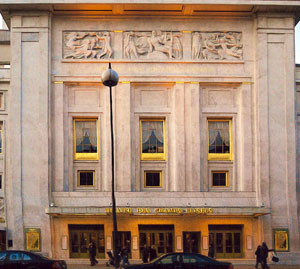 |
 |
Théâtre des Champs Elyssées, Paris
|
On his prologue to the book "17 Visages de la Danse française" (Irène Lidova, Paris, 1953), Philippe Hériat* academician from the Goncourt Academy, writes: "The 20th Century's French ballet was about to have its beginnings but during war's time. It's after this last war we know it exists. It developes in front to our eyes. And no doubt we should not search further the reasons of a favoritism that astonishes the theatre's world: public goes towards that which is unfolding."
"It is now, less than ten years after the war's end, that French dancers or those who are better called so, appear in full light. Their international class is no more in dispute. It had escaped them until now. With Diaghilew one can find Russians, Polish, even English, not French. And we might say that in revenge, the Paris Opéra, the only choreographic activity center in France during the first thirty years of the century, produced good dancers and even stars of first rank, but the majority of which remained this side of the international class."
"A new school was needed and, on one hand, it was likewise the Opera' school. But renewed by one of Diaghilew's heirs. The successful effects, longtime feeled, of Serge Lifar's entry at the Palais Garnier are not disputable. He awaked the methods, stimulated youth. He created ballet spectacles, which created themselves at the house the necessity of dancers: dance was recovering its rank. The Opera's foyer was burning."
"At the same time, in Paris they were opened dance studios like never before had existed among us. Those from former Imperial dancers. New York had its own, maybe London and Berlin, but Paris had the greatest number. There it was a new atmosphere and new disciplines, one might say a new mystic, and new dancers could rely there on great masters. This professionals and this technicals, in years to come, assured between them the relief and the continuity of their teachings; this is still going on: Irène Lidova, who knows them better than anybody else, will remember on this book their beautiful names."
"Even before the war a first group of students had sprout out of the hands of this teachers. But they were absorbed and trained by already formed companys, blending themselves with the cosmopolitan Ballet' effectives. Some of this dancers, on the other hand, were not French not even by adoption. And when their cadets entered at their time on their fertile studios, taking possession of the barre, a specific renewal was produced: it was indeed the French's turn."
"The incubation of this new generation of students was produced through four years within the Occupation's enclosure. The physic and moral sternness of this period, its evils and illnesses, couldn't prevent the dance' desire of being satiated; perhaps, in such young hearts, they exaltated it. But which attraction pole to adhere to? More foreign corps de ballet arriving at Paris, more international stars giving performances; they were also some isolated galas and dance "concerts"...It was still the Opera, scene and hall, in spite everything, who gave a refuge. There were meeting all those to whom dance, at the end of a perspective of proofs, waiting and hopes, shined like the image itself of a free life."
"And everything was liberated. War was over, the elite of these boys and girls composed a dozen of ready dancers, who weren't students anymore. They are those who in November 1944 performed at the soirées de dance organized by Irène Lidova at the Théâtre Sarah-Bernhardt, and the inscription of their names at the program : Jean Babilée, Nina Vyroubova, Roland Petit, Renée Jeanmaire, Colette Marchand, coincided with the return of the very name of Sarah-Bernhardt at the frontispiece of the façade. Realized through improvised means, on a borrowed hall, this performances deserve a place on the choregraphic annals because they were the first appearing of many dancers famous at the present time, and because they gave birth to the Ballets des Champs-Elyssées, the first French independent troupe on Dance' history. "
"The work we're about to read is consecrated to this war's generation who, by the way, suffered without disadvantage being compared with the starlets generation born in the 40th's on the theatres and the photographic studios. On this dancers sons of the black-out lies the dance' hope of the entire world. They are not all French per cent and their names have sometimes foreign sounds; but, born from both French parents like Michel Renault and Jacqueline Moreau, or from emigrant Russian parents like Wladimir Skouratoff, or from French mother and Russian father like Ludmilla Tcherina and Serge Golovine, or from Russian mother and French father like Irène Skorik, it's the air from l'Ile-de-France that entered their lungs after the first cry, it's over our horizons and our monuments that their regards were enlarged, it's our asphalt that their predestined feet first stepped on."
"It's upon them that French ballet is made of."
(*) author of the libretto for "Piège de lumière" (Damase-Taras)
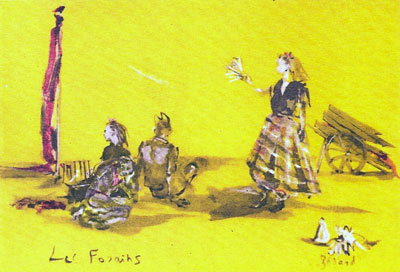 |
 |
Les Forains, two drawings by Christian Bérard, 1945
|
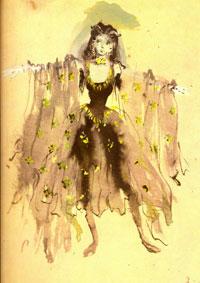 |
 |
La Loïe Fuller |
Marie-Françoise Christout, on her article Les Ballets des Champs-Elyssées: A legendary adventure (Dance Chronicle, 2004) wrote about "Les Forains": "The poetic libretto had been the inspiration of Kochno: the joyous arrival of the strolling players, the preparation for the show and the succession of acts, the small takings, and the melancholy departure from the deserted public square. He convinced Sauguet to compose the music quickly and as soon as they were finished to bring the sections of the score to Petit, who feverishly set the choreography. With his genial sense of the theatrical, Bérard discovered castoff clothes at the Marché-aux-Puces, which he transformed by painting them or burning them with his cigarette. (...) Old canvases, quickly stretched, suggested the humble circus, lit by Kochno. No one who had the privilege of attending this memorable evening will ever forget it."
"(...) In the program, Cocteau wrote, "Kochno, who used to help Diaghilew in his work, today organizes a true feast of youth and dance".
We want to point out that Hélène Sadovska, one of the members of Les Forains’ original cast, was also the model to Christian Bérard for the design of La Loïe Fuller’s costume.
We want to remember here the words of the english critic John Percival, who wrote about the interpretation of Wladimir Skouratoff in “Les Forains” in London in 1951: “There are two rôles above all in which Skouratoff gave interpretations of such compelling force that they remain persistently in my memory. One was Petit’s own rôle of the Conjurer in Les Forains, and the other, the escaped convict in Tara’s Piège de lumière. In the Petit ballet, Skouratoff was by authority and inventiveness definitely the leader of the little troupe of strolling players right from his first entrance. Although he suggested the weariness of the man at the begining of another hopeless one-night stand, he nonetheless remained the most alive of the players, inspecting the tent as it was erected, aiding and encouraging his colleagues. And then, during the circus performance, what charm he showed as ringmaster. All the time, by his own reaction, he led the eye of the spectator to the performer in action, then to the tent from which the next was to appear.”
“With little gestures and momentary expressions he controlled all reactions to what the other dancers were doing. With his forefinger pressed against a thumb, or a hand cupped round one ear, with a kiss of the fingers or a knowing look, he prepared the way for the others or emphasised the highspots of their solos. He was like a chef, minutely supervising the preparation of some confection; he loaded his part with infinite detail, yet kept a light touch throughout , and the ballet took fire from his ardour.”
“When the time came for his own contribution to the circus, he danced easily, gaily, charmingly. Even the “magic” tricks were done adroitly than usual – he needed no handkerchief, for instance, to mask the flowers which materialised in his hand.”
(John Percival, Dance and Dancers, 1959)
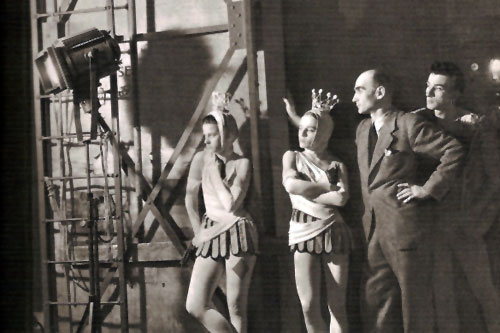 |
 |
Boris Kochno, Roland Petit, Nathalie Philippart and Hélène Sadovska
(photo: Lipnitski) |
The same author wrote about "Le Rendez-Vous": "(...) But the suggestive cruelty of Petit's new ballet Le rendez-vous fascinated the audience. Jacques Prévert, who had earlier written the script of the famous film Les enfants du paradis, wrote the libretto, with music by Joseph Kosma. For sets, Prévert, Petit and Mayo, who designed the costumes, decided to use enlargements of photographs by Brassaï representing a bar or the pillars of the elevated métro tracks. The stage curtain by Picasso instantly created a dramatic atmosphere. In a seedy district of Paris - whose poetical realism was often glorified by the film director Marcel Carné - one evening a tormented young man obtains a reprieve from Fate, which was ready to order his death, under the pretext that he has an appointment with "the most beautiful woman in the world", standing there in her high heels. At the end of their pas de deux, which was striking in its provocative eroticism, she cuts his throat with Fate's razor. (...) The next day André Warnod declared in Le Figaro that "These ballets would be worthy of representing French art abroad."
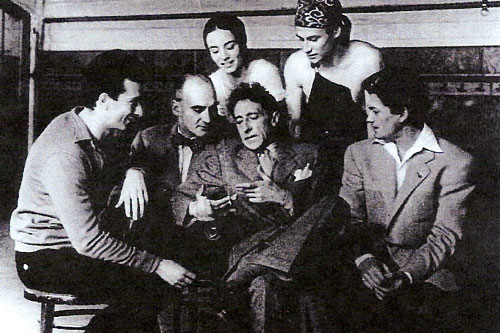 |
 |
Roland Petit, Boris Kochno, Nathalie Philippart, Jean Babilée and Jean Marais
listen to Jean Cocteau (center)
(photo: Serge Lido, 1946)
|
Les Ballets des Champs-Elyssées had their première in London on April 1946, at the Adelphi Theatre.
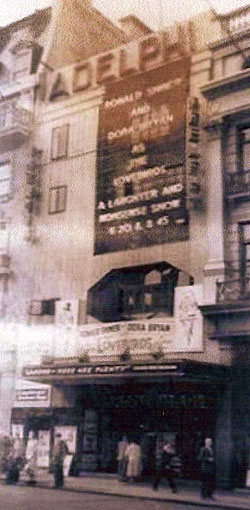 |
 |
The Adelphi Theatre, London
|
They made numerous tournées afterwards in the United Kingdom, where on September 20th, 1948, at the Prince's Theatre, David Lichine presented for the first time his ballet "La Création".
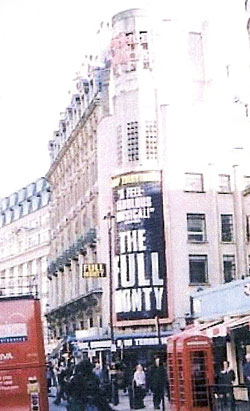 |
 |
The Prince´s Theatre, London
|
During the many tournées of Les Ballets des Champs-Elyssées at London, Wladimir Skouratoff had a remarkable participation, raising a shared praise and admiration from the English public and critics, like John Percival, Elsa Brunelleschi, Cyril Beaumont or Clement Crisp, who in a "Tribute to David Lichine" refers to the ballet "La Création" as follows: "In 1948, working for Les Ballets des Champs-Elyssées, he (Lichine) staged "La Création", a work danced in silence (and one of the very first to be given thus), in which the coreographer summoned into life the bodies of his dancers. The piece was intellectually stimulating as well as dramatically vivid: the rôle of the Choreographer was made for the outstanding danseur Vladimir Skouratoff , whose noble and poetic manner was admirably used."
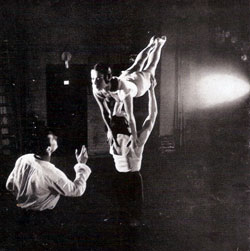 |
 |
Skouratoff and Sonia Arova in "La Création"
|
On November 12th 1949, at the Théâtre des Champs-Elyssées, Yvette Chauviré and Wladimir Skouratoff danced for the first time the Grand Pas Classique, music by Auber, which Victor Gsovsky had made specially for them.
Marie-Françoise Christout wrote at her work before mentioned: "The victim of serious internal dissension and growing financial difficulties at a time when state subventions did not yet exist in France and private sponsorship was becoming rare, the company gave its last performances at the Théâtre des Champs-Elyssées from June 13 to 24, 1950, under the name Les Artistes Associés de la Danse. New dancers in La rencontre and Les Forains were eclipsed by the eagerly awaited return of Yvette Chauviré. She appeared not only as a dancer, but also as the choreographer of Suite Romantique, to music by Chopin, and of the pas de deux L'Oiseau de Feu, to Stravinsky, that she had recently presented at the Casino in Vichy. The critics especially appreciated the ballerina's purity of style and her radiant grace, as well as the elegance of Wladimir Skouratoff, her partner. On June 16 they appeared with Gérard Ohn in Nocturne, a new pas de trois by Victor Gsovsky set to Mozart, with costumes by the couturier Pierre Balmain. Then on June 20, they danced L'Ecuyère, choreographed by Serge Lifar in a neoclassical style to music by Joseph Kosma, a libretto after Franz Kafka, and costumes by Constantin Nepo, Chauviré's husband."
 |
 |
In "L'Ecuyère"
(photo: Lido)
|
"After a long break in which Kochno searched for new dancers and choreographers, the now very small company toured Germany May 1-13, 1951, in Freiburg im Breisgau creating L'Impromptu au Bois by the American choreographer Ruth Page, set to Jacques Ibert's cheeky Divertimento, with set and costumes by Georges Wakhévitch. They also performed Serge Lifar's Aubade, with a libretto after Ovid's tale of Diana and Acteon, to a score by Francis Poulenc. The company then danced at the Palermo Festival from June 15 to 18 and went on to a successful engagement in London from August 2 to 29 at the Cambridge Theatre."
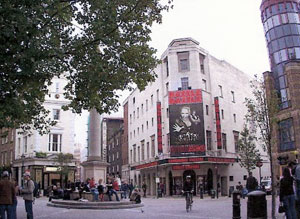 |
 |
|
"Youli Algaroff was now promoted to ballet master, surrounded by such company veterans as Danielle Darmance, Hélène Trailine, Deryk Mendel, Igor Fosca, and the now renamed Violette Verdy, who had been promoted to étoile. Some new dancers also joined the company, including the elegant Jacqueline Moreau (deserting the Paris Opéra), Wladimir Skouratoff, the dramatic British dancer Paula Hinton, the Bulgarian-British Sonia Arova, and the American virtuoso Leon Danielian. In this last episode of its saga, the company still had class, but its spirit was different because of its now-international character, so different from its French-Parisian beginnings on a peaceful summer night seven years earlier."
"For its last performances in Paris, the company was welcomed from October 3 to 31 at the Théâtre de l'Empire, where the frequently brilliant Grand Ballet du Marquis de Cuevas often had its triumphs. The rough but always tasteful Kochno had found a dangerous rival in the rich and snobbish "kissing Marquis". This swan song was marked by three Paris premieres by British and American choreographers. Two recent Prix de Rome winners - the composer Pierre Petit and the architect Guillaume Gillet - collaborated on Romanza Romana with Franck Staff, the choreographer, who made of it "a trifle, but a nice one", according to Olivier Merlin. It told of a tourist voyage leading to a romantic idyll, with Danielle Darmance and Wladimir Skouratoff as the young lovers, and Deryk Mendel as the girl's aunt. Despite Minkus'music, both the critics and the audience preferred Petipa's Don Quixote pas de deux, brillantly danced by Jacqueline Moreau and Skouratoff."
Romanza Romana was presented on October 3, 1951 at the Théâtre de l'Empire, with Wladimir Skouratoff, Danielle Darmance and Deryk Mendel.
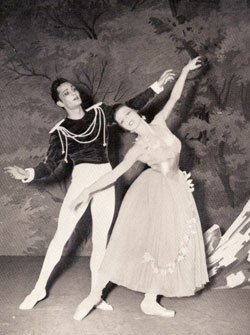 |
 |
Skouratoff and Jacqueline Moreau
in
Romanza Romana
(photo: Lido)
|
"About the season's second novelty, shown on October 8, Claude Baignères wrote, "The essential part of L'Impromptu au Bois is the music and the first merit of Ruth Page's choreography is to go along with it." Ibert's score, close to the music of Emmanuel Chabrier in its malicious boldness, was assisted by the fantasy of Georges Wakhévitch, who painted a pleasant Bois de Boulogne peopled with young midinettes and cyclists wearing knickers (...)"
L'Impromptu au Bois was presented on May 1st, 1951 on Freiburg im Breisgau, with Wladimir Skouratoff, Danielle Darmance and Deryk Mendel.
According to Christout, "In strong contrast to this impulsive sketch, Revanche allowed Page to show fully her dramatic sense by skillfully stylizing the complex action of Verdi's Il Trovatore, with a score arranged from the opera by Isaac van Grove. (....) the great success went once again to Clavé, whose sets and costumes for Revanche boldly contrasted deep black with gray, indigo, purple, green, and bright yellow to provide a striking vision of Spain: the dark courtyard of Count de Luna's castle - where first court dances and then the duel for the two opposing brothers, the Gypsy-galant Maurice and the jealous Count de Luna, took place- was a severe as the Escorial, followed by the evil night-shadowed Gypsy camp, a dismal jail, and a great hall in the Gotic style surmounted by a great stained-glass window in the manner of Georges Rouault. Here the characters in this choreographic melodrama confronted one another in a rapid and brutal rhythm. In a fit of madness, the old Gypsy (Sonia Arova) takes her revenge to the full, provoking the tragic death of the lovers, virile Maurice (Wladimir Skouratoff, whose elegance the critic Olivier Merlin compared to that of the bullfighter Luis-Miguel Dominguin) and the exquisite Leonore of Jacqueline Moreau".
Revanche was presented on October 16, 1951, at the Théâtre de l'Empire, with Wladimir Skouratoff, Jacqueline Moreau, Sonia Arova and Gérard Ohn, and was the penultimate performance of Les Ballets des Champs-Elyssées in Paris.
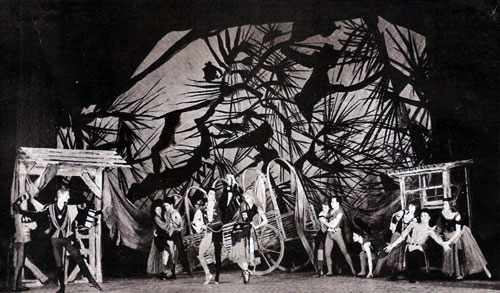 |
 |
Skouratoff, Arova and Ohn in "Revanche"
(photo Serge Lido)
|
After the performance of the ballet "La Damnée" by Walter Gore, on October 29, 1951, in Paris, the final curtain was fallen for this Company, a forerunner on its Country, an innovator for the world, and, in Marie-Françoise Christout' words in 2004: "Half a century later, apart from the scores, the fascinating sketches for sets and costumes, photographs, and many written testimoines, Les Ballets des Champs-Elyssées leaves only a precious trace in the memory."
As a distinguished man of the theatre with a particular interest in dance and mime, Jean-Louis Barrault particularly celebrated Kochno as the perfect producer: "the one who knows how to maneuver in the midst of so many obstacles, so many traps; the one, in short, who has the power not to wear himself out". Is it not to this Russian magician, the shrewd and exacting heir of Diaghilew, that we owe the revelation of memorable artists and works, thanks to the ephemeral spring of a small French company which so quickly became legendary? "
|
|